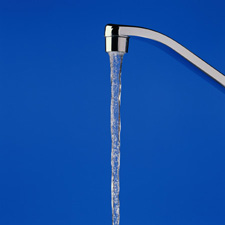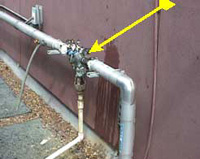Section II:C. Domestic Water Systems
 Domestic water systems are designed to provide cold or heated water for washing, cleaning, consumption, etc. The term "domestic"
applies to all non-process water used for lavatories, showers, drinking fountains, etc., in commercial, residential, and industrial settings.
These systems usually include a boiler or heater, a recirculating piping system, and pipes terminating in taps and fixtures. Operating
temperatures vary depending on system design, energy conservation programs, and intended use of the water.
OSHA Recommends that you identify all parts of domestic water systems that may contribute to the amplification of
Legionnaires' disease bacteria (LDB): Domestic water systems are designed to provide cold or heated water for washing, cleaning, consumption, etc. The term "domestic"
applies to all non-process water used for lavatories, showers, drinking fountains, etc., in commercial, residential, and industrial settings.
These systems usually include a boiler or heater, a recirculating piping system, and pipes terminating in taps and fixtures. Operating
temperatures vary depending on system design, energy conservation programs, and intended use of the water.
OSHA Recommends that you identify all parts of domestic water systems that may contribute to the amplification of
Legionnaires' disease bacteria (LDB):
 Tepid Water Systems Tepid Water Systems |
Warm or tepid water systems that dilute domestic hot water from a water heater with cold water upstream from the outlet are not recommended.
- Warm water left in these lines is at ideal temperatures for growth of LDB.
- Localized mixing at the source to temper very hot water is more acceptable.
- Another alternative is "instantaneous" point-of-delivery heating of water using individual steam heating systems at each outlet.
|
 Parts Identification Parts Identification |
 |
| Fig. 1: Backflow preventer |
Many variables can contribute to the growth of LDB in domestic water systems. Review the following system components to reduce and eliminate
LDB amplification:
- Identify all parts of the domestic water systems where water may stagnate such as "dead legs" (sections of piping or plumbing that have been altered or capped such that water cannot flow
through them) or storage tanks that are not frequently used.
- Remove dead legs along with unused equipment and water lines from the system.
- Eliminate or minimize the use of rubber, plastic and silicone gaskets in the plumbing system. These materials may serve as growth substrates
for LDB.
- Identify and test the integrity of all backflow preventers (to assure protection of domestic water from cross-contamination with process water) through a building code-approved method.
|
|
|
